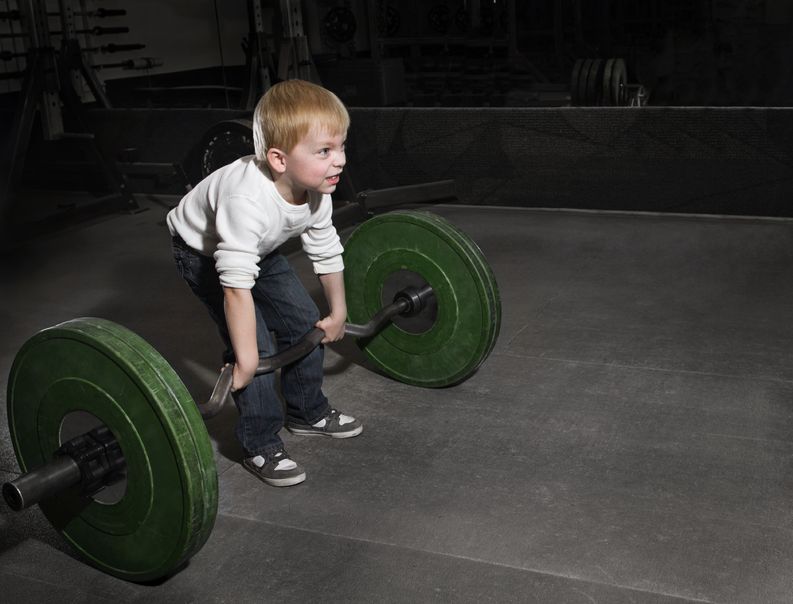Strength training for kids can be quite controversial. Videos like this one frequently go viral on social media sites like Facebook. You see a child who has honed the craft of sometimes CrossFit and sometimes, simply Olympic weight lifting who now has the ability to out-lift many adults.
Strength training for kids isn’t a foreign concept to most CrossFitters — CrossFit HQ boasts its own CrossFit Kids program. Even most high school athletes engage in weight lifting to build endurance and muscle on and off the field and court. However, there’s a lot of speculation around whether or not strength training for kids is safe.
Between anecdotal “research” and faulty science published over twenty years ago, the jury on whether or not incorporating weights into a child’s fitness routine is out — or at least a little confused. Contrary to popular opinion, strength training is safe for children and does not damage growth plates or stunt growth in any way.
Strength training for kids has gotten quite the reputation, but what are the facts?
Weight Lifting vs. Strength Training for Kids
 To begin to unravel the mystery surrounding the bum rep that weights have gotten for children, it’s important to understand the distinction between strength training and weight lifting.
To begin to unravel the mystery surrounding the bum rep that weights have gotten for children, it’s important to understand the distinction between strength training and weight lifting.Strength training, simply put, is incorporating weights into a fitness routine to increase strength and anaerobic endurance. It also incorporates using free weights and body weight to use resistance to increase strength. Although many would argue that weight lifting means approximately the same thing, there is a competitive connotation. In fact, weight lifting for sport is not only popular, but actually an Olympic sport.
Is one safer than the other? It depends.
Is it Safe for Children?
Strength training is in no way unsafe for children. In fact, children who incorporate strength training into their fitness routine or use strength training as a way to get exercise in can enjoy lots of benefits including (obviously) increased strength, better endurance, stronger bones and even less chance of injury down the road.
Weight lifting is often frowned upon for children, but as the CrossFit Kids program has proven — it isn’t necessarily unsafe. Similar to adults, weight lifting can be unsafe for children who are inexperienced, don’t understand proper techniques, or who are lifting weights without proper supervision. However, for children who practice proper lifting form regularly underneath the supervision of an attentive coach, weightlifting and CrossFit can be a fun activity for almost any age.
What About Growth Plates?
The common misconception behind why any sort of weight-involved training is dangerous is because of the risk of damaging the growth plates.
Growth plates are bits of tissue attached to the ends of the longer bones in the body. Throughout childhood, these plates are vulnerable bits where (again, obviously) growth happens. Growth plates help lengthen the bones as children grow and then in adolescence, after they’ve grown as much as they’re going too, they harden into regular bone.
Growth plate injuries are common in children because the plates are very fragile — even more so than a tendon or a joint — and often times, injuries are absorbed in the growth plates. Fractures can cause damage to the growth plate which can later stunt growth.
For many years, it was commonly thought that weight lifting/strength training/using weights for children to exercise was dangerous because of high growth plate injury rates. In fact, the American Academy of Pediatrics made this their official status on weight lifting in the early 1980s, something they’ve since corrected.
Since then, data has indicated that there is no connection between increased injuries and weight lifting. Most growth plate injuries occur during normal childhood activities such as team sports, playing around the home, or riding bikes.
In fact, research suggests that many common growth plate injuries, especially those obtained while playing sports, could have been prevented “…in large part by youth strength and conditioning programs,” as quoted in a powerful article produced by CrossFit Kids in 2008 in favor of children engaging in weight lifting and CrossFit.
When Weight Lifting Isn’t Safe for Kids
Although most data indicates that weight lifting and strength training is nothing but beneficial to children when done correctly and with supervision, there are some aspects that can pose a risk to your child’s health.
Children should not one-rep max, or find the maximum amount of weight they can utilize in any given lift. According to CrossFit Kids, “We do not endorse max effort lifts for kids. We believe in using the smallest stimulus possible to achieve the training effect desired, whether young or old. Due to their still developing neuromuscular systems, kids receive a training effect from sub maximal efforts.
“Ignoring this is foolish, reckless and exposes kids to the same risk of injury that other age groups risk when going for max efforts. It is the hallmark of a bad trainer to expose young clients to this risk. Gradual exposure provides significant results while avoiding the pitfalls of excessive loading and max efforts in children and teens.”
The American Academy of Pediatrics also backs this stance, saying that, “Preadolescents and adolescents should avoid competitive weight lifting, power lifting, body building, and maximal lifts until they reach physical and skeletal maturity.”
Strength Training for Kids is Safe
All this to say, there is overwhelming evidence that not only is your child safe lifting weights as a part of a strength and conditioning routine, but they will most likely benefit on the field or court and as they continue to grow.
There are still conditions — form is important and children shouldn’t be entering Strongman competitions — but for the most part, strength training and weight lifting is a great way to round out your child’s fitness routine.
References
